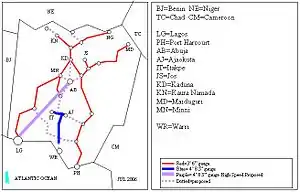Nigerian Railway Corporation
Nigerian Railway Corporation (commonly abbreviated as NRC) is the state-owned enterprise with exclusive rights to operate railways in Nigeria.

History and legislative background
The Nigerian Railway Corporation traces its history to the year 1898, when the first railroad in Nigeria was constructed by the British colonial government. On October 3, 1912 the Lagos Government Railway and the Baro-Kano Railway were amalgamated,[1] starting nationwide rail service under the name Government Department of Railways. With the passing of the Nigerian Railway Corporation Act of 1955, the company gained its current name as well as the exclusive legal right to construct and operate rail service in Nigeria.[2] The rail network reached its maximum extent shortly after Nigerian independence, in 1964. Shortly after that, the NRC entered a long period of decline, inept management, and eventually a complete lack of maintenance of rail and locomotive assets. In 1988, NRC declared bankruptcy, and all rail traffic stopped for six months. After that, trains resumed, where the tracks were usable. By 2002, passenger service was again discontinued altogether.[3] Starting in 2006, plans were made to restore the rail lines and add new locomotives with foreign assistance. In December 2012 regular, scheduled passenger service was restored on the Lagos to Kano line.
Infrastructure and operations
Nigerian Railway Corporation operates a network of 3,505 kilometers (2,178 mi) of single track lines 1,067 mm (3 ft 6 in) gauge, as well as 1,435 mm (4 ft 8 1⁄2 in) from Abuja to Kaduna.
Stations
Trains
Trains offer relatively new rolling stock consisting of Couchette-type sleepers, air-conditioned first class sitting coaches and non-air conditioned economy class coaches. Trains to/from Lagos also offer buffet cars. Between Lagos and Ifo, a distance of 48 kilometers (30 mi), a local service operates on working days on behalf of the city of Lagos.
All trains are diesel locomotive operated. The railways owns nearly 200 locomotives, of which up to 75% are not operational. It also owns about 54 shunters, 480 passenger coaches and over 4900 freight wagons; less than 50% of the coaches and wagons are in serviceable conditions.
No trains have run on the Gusau branch since a bridge collapsed in Tsafe in 2002.[4]
Recent history
NRC went more than once into bankruptcy during the last 20 years. Lack of maintenance on infrastructure and rolling stock and a high number of employees the railway produced huge deficits, not taken over by the state. In 2005 after several re-organisations of the system passenger transport was reduced to four departures weekly from Lagos of which two went to Kano, one to Jos and one to Maiduguri; from Port Harcourt four trains every week ran to Kano (two weekly), one weekly to Jos and one to Maiduguri.
Status in 2008
According to the critique by Mazi Jetson Nwakwo, acting managing director of the NRC the rail system is suffering from the lack of political will by the nation's politicians. While the NRC had employed about 45,000 people between 1954 and 1975, current employment is only 6,516.[5] He pointed out that no new wagons had been bought since 1993, and some wagons date back to 1948. Track condition limits trains to a speed of 35 km/h.
See also
References
- Stocker, John. Nigerian Railway Jubilee, 1901-1951: An Illustrated and Descriptive History of the Nigerian Railway (Lagos Railway, Wushishi Tramway, Baro Kano Railway), 1951. Retrieved November 12, 2013.
- http://nrc-ng.org/projects/about-nrc
- "Nigeriaworld Feature Article - The urgent need for rail transportation in Nigeria". nigeriaworld.com. Retrieved 2017-08-30.
- "RAIL CLOSURE PREJUDICES ECONOMY". Railways Africa. Retrieved 2010-11-17.
- Railways Africa report, accessed 2/6/2008
- "trans zambesia locomotive, AEI, malawi locomotive, nigeria locomotive". www.derbysulzers.com. Retrieved 2017-08-30.